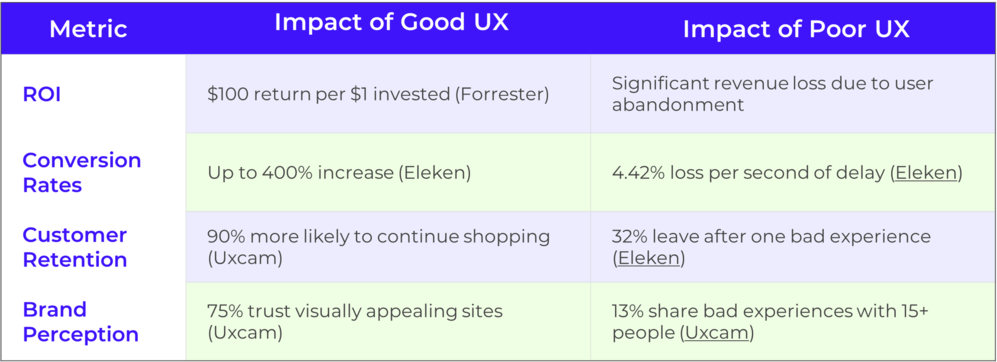

Rohan Sridhar
Posted On: June 06, 2025
Share
In today’s digital-first world, the success of any IT company hinges on one critical factor: the user experience (UX) of its products and services. As C-level executives, you understand that every decision must drive business growth and profitability. What you may not fully realize is that investing in good UX design is not just a nice-to-have; it’s a strategic imperative that can transform your bottom line.
As Steve Jobs once said, “Design is not just what it looks like and feels like. Design is how it works.” This philosophy underscores the essence of UX design: creating products that are not only aesthetically pleasing but also functional, intuitive, and efficient. At Happening Design, we believe that UX design is the cornerstone of digital success. In this article, we explore why UX design is indispensable for IT companies, backed by compelling statistics and insights from industry leaders. We’ll also provide actionable strategies to help you harness the power of UX design for your business.
The Business Case for UX Design

The financial impact of UX design is undeniable. Let’s start with some hard numbers:
- ROI on UX Investment: Research from Forrester suggests that for every dollar invested in UX, companies can see a return of $100—an ROI of 9,900%. This makes UX design one of the most lucrative investments a company can make.
- Conversion Rate Improvement: Good user interface (UI) design can increase conversion rates by up to 200%, while exceptional UX design can boost them by up to 400% (Eleken). This translates to more sales, sign-ups, and revenue.
- Customer Loyalty: 88% of users are less likely to return to a website after a bad user experience, while 74% are likely to return to a site with good mobile UX, and 90% are more likely to continue shopping with companies that provide great UX (Uxcam).
- Willingness to Pay More: 80% of users are willing to pay a premium for a better user experience, allowing companies to increase both sales volume and pricing power.
These statistics are not just abstract numbers; they are reflected in real-world success stories. For example, an e-commerce website changed a single button from “Register” to “Continue” and added a message assuring users that no account was needed for purchase. This small UX tweak resulted in a 45% increase in sales, generating an additional $300 million in revenue (UIE). Similarly, HubSpot, a leading CRM platform, redesigned their record page, focusing on usability, which led to a 33% increase in total revenue, reaching $1.731 billion (HubSpot). Another case is SEOcrawl, an SEO tool provider, which partnered with Eleken for a UX redesign. By incorporating user feedback and adding new features, they doubled their user base and attracted new paid customers, significantly boosting business growth.
These examples demonstrate that UX design is not just about making things look pretty; it’s about driving measurable business results. By investing in UX, companies can achieve higher conversions, greater customer retention, and increased revenue.
UX Design as a Competitive Advantage
In a market where products and services are increasingly commoditized, UX design can be the differentiator that sets your company apart. According to Forrester, companies that prioritize UX design grow twice as fast as the industry benchmark. A McKinsey study further supports this, showing that companies prioritizing design achieve 32% higher revenue growth and 56% higher total return to shareholders. Here’s why UX design is a game-changer:
- Brand Differentiation: In a crowded marketplace, UX design can make your product stand out. Apple has built its brand on superior UX, turning functional devices into must-have lifestyle products. Similarly, Airbnb and Uber have disrupted their industries by focusing on seamless, user-friendly experiences that resonate with users.
- Customer Retention: Loyal customers are the lifeblood of any business. A seamless and enjoyable user experience fosters loyalty and encourages repeat business. For instance, 23% of users who have a positive UX share their experience with 10 or more people, amplifying your brand’s reach (Uxcam).
- Market Growth: Companies with top design practices not only retain customers but also attract new ones. The SEOcrawl case study illustrates this, where a UX redesign led to a doubled user base and new paid customers, showcasing how UX can drive market expansion.
Jonathan Ive, Apple’s former design chief, once said, “Very often design is the most immediate way of defining what products become in people’s minds.” By investing in UX design, you’re not just improving your product; you’re building a brand that resonates with users and stands out from the competition.
The Cost of Poor UX Design

Neglecting UX design can have severe consequences. Consider these sobering statistics:
- User Abandonment: 32% of customers will stop interacting with a brand after just one bad experience, and nearly 60% after several bad experiences (Eleken). In the digital realm, a bad experience can be as simple as a slow-loading page or a confusing navigation menu.
- Conversion Loss: Each additional second of page load time can cause a 4.42% loss in conversion rates. A 1-second delay can lead to a 7% decrease in conversions, potentially costing e-commerce sites millions (Uxcam).
- Reputation Damage: 13% of customers will tell 15 or more people about their bad experiences. In the age of social media, negative word-of-mouth can spread rapidly, damaging your brand’s reputation.
- Missed Opportunities: Only 1% of users say that e-commerce websites meet their expectations every time, meaning the vast majority are leaving websites dissatisfied, missing out on potential sales.
Poor UX can also alienate mobile users, who are five times more likely to abandon tasks if a site isn’tmobile-optimized. Additionally, 48% of customers feel that poor mobile design implies a company doesn’t care about their business, further eroding trust. The cost of poor UX design is not just in lost sales but also in damaged brand perception and missed growth opportunities.
The Future of UX Design

As we look to 2025 and beyond, UX design is evolving rapidly. Here are key trends that C-level executives should be aware of:
- Mobile-First Design: With mobile usage surpassing desktop, ensuring a seamless mobile experience is critical. 85% of users expect a company’s mobile site to be as good as or better than its desktop version (Uxcam).
- Cross-Device Consistency: 83% of consumers believe that a seamless UX across devices is essential. Designing for consistency across smartphones, tablets, and desktops is a must.
- Personalization: 58% of users view companies more favorably when mobile sites or apps remember their identity and preferences. Personalization creates tailored experiences that drive engagement.
- AI and Automation: Artificial intelligence is revolutionizing UX design by enabling intuitive and responsive interfaces. AI can analyze user behavior to predict needs and provide proactive solutions.
- Voice and Gesture Interfaces: With the rise of voice assistants and gesture-based controls, UX designers must adapt to new interaction paradigms to stay relevant.
Dr. Elizabeth Gerber, co-director of the Center for Human-Computer Interaction + Design at Northwestern University, noted, “Adaptive and responsive design is no longer a nice to have; it’s a requirement.” Staying ahead of these trends ensures your company remains competitive in the ever-changing digital landscape.
How to Implement Effective UX Design

To leverage UX design effectively, consider these actionable steps:
Prioritize User Research: Understand your users’ needs, pain points, and behaviors through surveys, interviews, and usability testing. Companies with well-integrated user research notice a 30%-70% positive impact compared to those where research is limited (Eleken).
Set Clear Goals: Define measurable objectives for your UX initiatives, such as increasing conversion rates or improving customer satisfaction scores.
Collaborate with UX Professionals: Partner with experienced UX designers who can translate business objectives into user-centered solutions. Happening Design’s expertise can guide you through this process.
Iterate and Test: UX design is iterative. Continuously test designs with real users and refine based on feedback to ensure optimal performance.
Integrate UX into Strategy: Make UX a core part of your product development process, ensuring it aligns with your overall business strategy.
By following these steps, you can transform UX design into a driving force for your company’s success.
Call to Action
UX design is not just a technical discipline; it’s a strategic asset that can drive business growth, enhance customer loyalty, and provide a competitive edge. For C-level executives, understanding and investing in UX design is crucial for navigating the complexities of the digital age.
At Happening Design, we specialize in creating exceptional user experiences that resonate with your audience and align with your business goals. Whether you’re looking to revamp your website, optimize your mobile app, or develop a new product, our team of UX experts is here to help.
Don’t let your business fall behind in the UX revolution. Contact us today at hello@happening.design to learn how we can transform your digital presence and drive your success.
Get the best advice from our top talented subject experts. Any time. Any matter.

